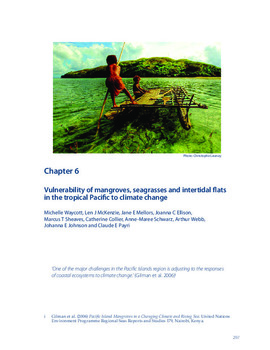Vulnerability of mangroves, seagrasses and intertidal flats in the tropical Pacific to climate change

Citation
Waycott, M. et al. (2011). Vulnerability of mangroves, seagrasses and intertidal flats in the tropical Pacific to climate change. p. 297-368. In: Bell, J.D. ; Johnson, J.E. ; Hobday, A.J. (eds.) Vulnerability of Tropical Pacific Fisheries and Aquaculture to Climate Change. Secretariat of the Pacific Community, Noumea, New Caledonia
Mangroves and seagrasses are of special interest to coastal fisheries worldwide because of the role they play in providing nursery areas for commonly harvested fish and invertebrates. Although the ecology of fish and invertebrates associated with mangroves and seagrasses in the tropical Pacific is not well understood compared with other parts of the world, the connectivity among mangroves, seagrasses, intertidal flats and coral reefs indicates that mangroves and seagrasses throughout the region provide a similar function to such habitats elsewhere. In this chapter, we assess the vulnerability of the mangrove, seagrass and intertidal flat habitats in the tropical Pacific that support coastal fisheries. We do this by examining the effects that changes to surface climate and the tropical Pacific Ocean (Chapters 2 and 3) are expected to have on the plants that define these habitats. This exposure to change is used in the framework described in Chapter 1 to assess the vulnerability of the habitats under representative low (B1) and high (A2) emissions scenarios from the Intergovernmental Panel on Climate Change (IPCC) for 2035 and 2100.
Permalink
Date Available
Type
Research Themes
Language